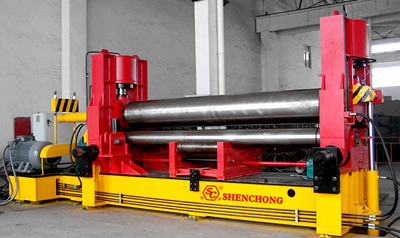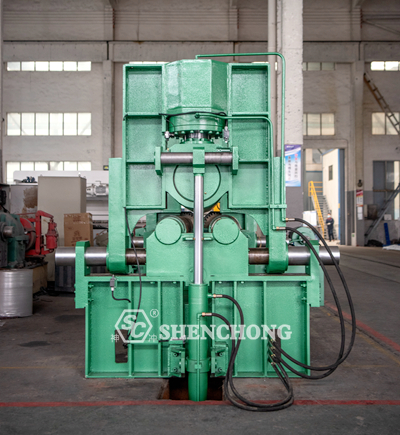
The reliability and service life of the hydraulic seals of CNC roll bender machine are an important indicator of the quality of the hydraulic system. In addition to gap sealing, the plate roll bending machine uses seals to control the gap between two adjacent coupling surfaces below the minimum gap through which the liquid that needs to be sealed can pass.
The seals in the hydraulic system of the roller bending machine are usually divided into two types: self-sealing compression seals and self-sealing self-tightening seals. However, the performance factors of various seals in the hydraulic system of the plate rolling machine are different, and they are affected by temperature, pressure and the presence of media.

The working principle of the plate bending machine is to use external forces such as hydraulic pressure and mechanical force to operate the work roller, and then bend or roll the plate into shape. According to the rotation and position changes of different types of work rollers, parts such as oval parts, arc parts, and cylindrical parts can be produced.
The hydraulic valve of the cnc roller bender machine is an automation component operated by pressure oil. It is controlled by the pressure oil of the pressure distribution valve. Usually used in combination with electromagnetic pressure distribution valves, it can be used to remotely control the on and off of oil, gas and water pipeline systems in hydropower stations.
The hydraulic valve of the roll bending machine is used to reduce and stabilize the oil pressure in a certain branch of the system. It is often used in clamping, control, lubrication and other oil circuits. The hydraulic valve of the plate roller bender is divided into direct-acting type and pilot type, and the pilot type is mostly used.
According to its type, it can be divided into flow control valves. This is to adjust the flow rate by adjusting the orifice area between the valve core and the valve body and the local resistance it generates, thereby controlling the movement speed of the actuator.
Flow control valves are divided into 5 types according to their uses. After adjusting the orifice area of the throttle valve, the movement speed of the actuator whose load pressure changes little and whose movement uniformity is not required is basically stable. Regardless of the size of the load, the diverter valve can make the two actuators of the same oil source obtain equal flow, which is called an equal-volume diverter valve or a synchronization valve. The proportional diverter valve is used to obtain proportional distribution of flow.
The collecting valve acts in the opposite direction to the diverting valve, so that the flow flowing into the collecting valve is proportionally distributed. The speed regulating valve can maintain the inlet and outlet pressure difference of the throttle valve at a constant value when the load pressure changes. In this way, after the throttle area is set, no matter how the load pressure changes, the speed regulating valve can maintain the flow rate through the throttle valve unchanged, thereby stabilizing the movement speed of the actuator. The diverter and collector valve has the functions of both a diverter valve and a collector valve.
Click here to know more about:
Working Principle of Hydraulic Plate Rolling Machine

The pressure of the cnc roller bender is quite large, and it can be said to play a very important role in the bending of the entire plate. As long as the thickness of the plate is small, bending is generally no problem.
Throughout the device we also notice its seals. We are all familiar with seals, which are often used to maintain sealing performance in many equipment that require sealing. What is the importance of seals in this device?
The components that play a sealing role in the hydraulic system, namely seals, are components used to prevent fluid or solid particles from leaking from adjacent joint surfaces and to prevent external impurities from invading the inside of the roll bending machine. External leakage will cause a waste of working media, pollute the machine and the environment, and even cause mechanical operation failure and equipment personal accidents.
The reliability and using life of the seals in the hydraulic system of the cnc roller bener are an important indicator of the quality of the hydraulic system. In addition to gap sealing, seals are used to control the gap between two adjacent coupling surfaces below the small gap that the liquid that needs to be sealed can pass. Among contact seals, they are usually divided into self-sealing compression seals and self-sealing self-tightening seals.
Internal leakage of the seals in the hydraulic system of the plate roller bender will cause the volumetric efficiency of the hydraulic system to drop sharply, failing to reach the required working pressure, and even making it impossible to work. Tiny dust particles that invade the system from the side will cause or aggravate the wear of the friction pairs of hydraulic components, further leading to leakage.
The leakage of seals in the hydraulic system of the plate bending machine will cause a waste of working medium, pollute the machine and the environment. And even cause operation failure of the plate bending machine and personal accidents.
The seals in the hydraulic system of the CNC roll bending machine are materials or parts used to prevent fluid or solid particles from leaking from adjacent joint surfaces, and to prevent external impurities such as dust and moisture from intruding into the internal parts of the machine equipment.
After the customer purchases the plate rolling machine for a period of time, since the sealing parts of the plate rolling machine are wearing parts, the customer needs to replace the sealing parts by himself. How to replace the sealing ring of hydraulic roll bender machine?
Before replacing the hydraulic cylinder sealing ring, prepare the following tools:
- Hydraulic cylinder sealing ring
- Lightweight hydraulic oil
- Dust-removing gauze or special cylinder cleaner
- Tools such as flat-nose pliers, needle-nose pliers and rubber mallets
- Remove the sealing ring: first remove the connecting screws on the hydraulic cylinder. Remove the end cap. Then use flat-nose pliers to gently clamp one end of the sealing ring and slowly remove the sealing ring.
- Clean the sealing ring: Use dust-removing gauze or a special cylinder cleaner to gently wipe the inside of the hydraulic cylinder, especially the position of the sealing ring. Prevent residue from remaining in the cylinder. Otherwise, the service life of the sealing ring will be affected.
- After removing the sealing ring, clean the area where the sealing ring is.
- Gently push the new sealing ring into the inside of the hydraulic cylinder from one end, gradually compressing and pushing it into place. Be careful to avoid deformation or damage of the sealing ring.
- Install the end cover back onto the hydraulic cylinder, and add some lubricating oil to lubricate the sealing ring.
- Before replacing the seal ring of the hydraulic cylinder, it is necessary to confirm whether the hydraulic cylinder is in a smooth state. It is necessary to confirm that there is no damage or deformation. Otherwise, replacing the new sealing ring will also cause failure.
- When replacing the sealing ring, avoid damaging the seal. Never use inappropriate tools to damage the sealing ring.
- If the sealing ring of the hydraulic cylinder leaks oil after being used for a period of time, it must be replaced in time. Otherwise it will affect the normal operation of the entire hydraulic system.

The above are the detailed methods and precautions for replacing the hydraulic cylinder seal ring. It should be noted that before replacing the sealing ring, be sure to ensure that the hydraulic cylinder is in normal condition to avoid using improper tools to damage the sealing ring. If the sealing ring leaks oil, it must be replaced in time to ensure the normal operation of the cnc roller bener hydraulic system.